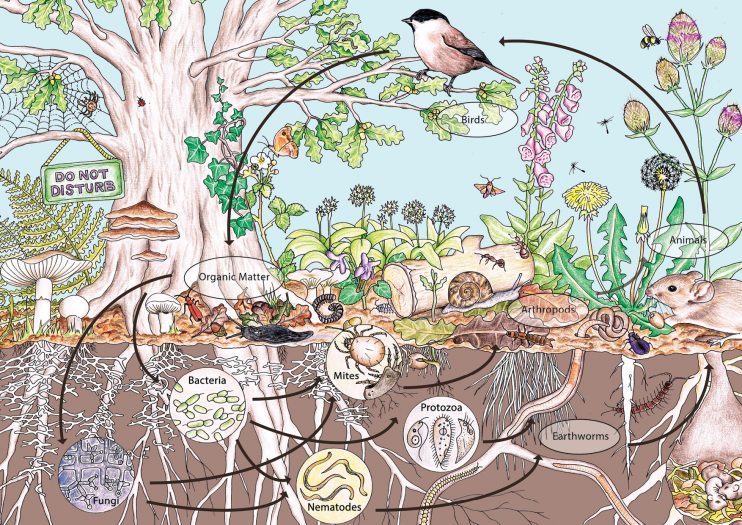Is it possible to produce abundant spaces that provide food, fibre and energy whilst building fertility and repairing the ecosystem? That’s what permaculture aims to do.
Permaculture means a whole lot of things to a whole lot of people but it is most commonly held as the use of design principles to provide a framework for growing spaces that mimic patterns and relationships found in nature to yield an abundance of food, fibre and energy. It’s also infinitely deep and can be the focus of a lifetime of study and learning but here’s a snapshot to give you some ideas of some of the aspects of permaculture.

Permaculture has had a lot of additions and has a lot of people who have different views but let’s start with the basics.
3 Ethics
- Animal Care
- Earth Care
- Fair Share
10 Permaculture Principles
Permaculture (and in fact the Town Movement) is based on some clear principles that were succinctly put by David Holmgren, one of the creators of Permaculture. These principles can be used on a garden space as they can be used in general life and are worth taking a moment to consider.
Click here to see the video presentation from David Holmgren about the process.
Some Permaculture Thinking Hints
Observe and Interact
Start by getting to know whatever environment you are working in. In permaculture the first step to designing a landscape is to observe and interact with your space. So whether you are setting up a group or planning a vegie garden, first… do nothing except observe. Take your time, look from different angles and at different times of the day. Notice the sun, the wind and the rain and the patterns they make. Notice who (and what) uses the space, how and when. Notice what is already there and maybe even get your detective on to determine what was there and any characteristics of the space that lie beneath the surface. The better you know the space you are working on (or with) then the more appropriate your application of design principles.
Take the time to think deeply about what you want and what the site could yield.
Part of permaculture involves accurately assessing the site and making detailed maps of the space and making note of what the space can support with its size, soil, aspect and climatic characteristics. It also involves accurately assessing the people who will inhabit the site. The more we can get to know what the people want and what resources, capabilities, skills and routines they have, the better we can try to meet these needs. Then these things need to be put together so that we have a space that not only fits the capacity of the site and the people but that emulates the natural systems (of the site and the people) and also produces a yield that motivates people to continue.
The story of the banana. Imagine an open community space and some enthusiastic and well meaning community members. They have a vision of a lush, verdant green community space so they set to with pick and shovel. They mulch, they weed, they plant berries, grapes and two bananas on a north facing wall and at the end of the day they look at what they have done and it is truly beautiful. But there are questions and observations that haven’t been made:
Is there any water on the site or anyone who has actually agreed to water our tropical banana plants?
What is the soil like?
Who will maintain this space, when and how… and what do they want?
Do the plants we’ve planted fit the location and aspect that we’ve planted them or did we simply put them where they looked good?
Forward a year and the space is in disrepair again. Many of the plantings have died including the banana plant that fried the first hot day in its dry exposed position. The vegie beds without water have turned to dust and the whilst there was initial excitement about maintenance, the constant battle with grass, weeds and now a blackberry that has run rampant makes it an unrewarding proposition.
The capacity of the site and the honest desires and capacities of the people who will inhabit it were never explored and do not match.
Consider closed loops and synergies
In nature there is no waste but circles, networks and a constant reworking of nutrients between animals, plants, bacteria and fungi. In our modern world we tend to think of things as individual and linear. I compost my garden bed, plant seeds, grow plants, harvest. In permaculture we are encouraged to think in closed loops. How can things synergise to increase overall productivity. If I plant climbing beans around my corn then I don’t need to put up trellises because the corn becomes the trellis. If I also put a pumpkin underneath then I have a growing mulch as well that will shade the soil. The bedding from my chook shed (a lovely mix of wood shavings and chicken poo) fertilizes the garden that then grows ‘chook fodder’ to feed my chooks who also help eat bugs and fallen fruit from the trees while digging up the grass and weeds.
The more we can think of relationships and synergies and emulating natural systems the less effort we need to put in fighting against those systems.
Put the things you visit most frequently closest. In permaculture we talk about sectors and zones. The zones are concentric circles (or circle-ish) that start at the house (zone 0). The basic concept is to put the things that you need to visit most frequently closest to the house and those that only need occasional visits further away. For example those culinary herbs or kale for your daily smoothie need to be close whereas that apple tree can be further away (though you might still want a dwarf lemon tree right up close to zone 0, if you need one for cooking each night or a G&T!).
If you would like to take the next step then consider a permaculture design course. Also check out permablitz who have a communal approach to planning and implementing a permaculture design.
Graphics and information from Richard Telford’s Permaculture Principles website https://permacultureprinciples.com/principles/
The beautiful permaculture image was created by Emma Lawrence https://www.emmalawrence.com/

